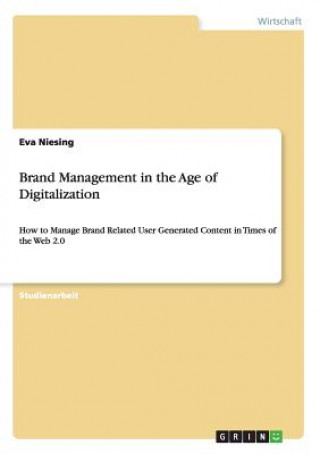
Dostawa
Doradca ds. zakupów





Jednak się nie przyda? Nic nie szkodzi! U nas możesz zwrócić towar do 30 dni
 Bon prezentowy
O dowolnej wartości
Bon prezentowy
O dowolnej wartości
Bon prezentowy to zawsze dobry pomysł. Obdarowany może za bon prezentowy wybrać cokolwiek z naszej oferty.
Brand Management in the Age of Digitalization
 Niemiecki
Niemiecki
 87 b
87 b
 common.delivery_to
common.delivery_to
30 dni na zwrot towaru


Studienarbeit aus dem Jahr 2014 im Fachbereich BWL - Marketing, Unternehmenskommunikation, CRM, Marktforschung, Social Media, Note: 1,3, Westfälische Wilhelms-Universität Münster, Sprache: Deutsch, Abstract: It s a lonely, scary time to be a brand manager (Fournier and Avery 2011, p. 193). Fournier and Avery s statement reflects that the brand management in times of the Web 2.0 has become a very complex and challenging undertaking. In this participatory online environment consumers are empowered to actively take part in the BM process instead of remaining passive receivers of the company s brand messages. Millions of people create and publish their own brand messages, also called brand related user generated content, in form of for instance YouTube videos, Amazon product reviews, Facebook groups and blog entries. Due to technological advances and the characteristics of the Web 2.0, these contributions from brand fans or brand critics can disseminate quickly and achieve important reach. Consequently, user generated brand messages represent important additional brand touch points next to the company s brand messages and may have a significant influence on the brand image (Burmann 2010, pp. 1 f.; Musser and O Reilly 2006, pp. 3-6; Wunsch-Vincent and Vickery 2007, pp. 9-17). Being still in its initial development phase, little knowledge exists on how brand managers should try to maintain the control over the BM process and approach brand related UGC. Instead of maintaining rather passive or simply monitoring these user contribitions, the BM may also counteract or even stimulate them in order to attain brand goals (Arnhold 2010, pp. 49 f.; Burmann 2010, pp. 1-3; Gensler et al. 2013, pp. 242-244; Hennig-Thurau, Hofacker and Bloching 2013, pp. 238 f.).§This paper s objective is to explain and classify different managerial approaches towards brand related UGC in times of the Web 2.0. Another purpose is to help managerial decision making by giving general recommendations on how to deal with these user generated brand messages. The paper is organized as follows: First, the author introduces a definition and the relevant characteristics of the Web 2.0. Chapter 2 presents the traditional BM process and explains how the Web 2.0 changed it. This theoretical background is followed by the introduction of the concepts of UGC and brand related UGC as well as its management in the third chapter. Based on the development of a new classification of managerial approaches towards brand related UGC, the author describes each approach and gives recommendations to brand managers. Finally, chapter four draws general conclusions and identifies promising areas for further research.
Informacje o książce
 Niemiecki
Niemiecki




 Jak kupować
Jak kupować














